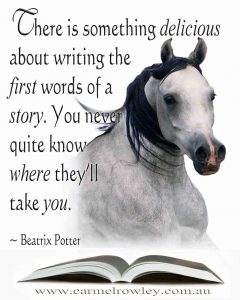THE ART OF STORYTELLING – LET’S BEGIN
How do you think of your stories? This is a question I’m often asked. Often there’s no easy answer other than saying that I’m always aware of what’s going on around me. These days if a story comes to me I try to write it down and always keep a pen in my handbag. I need to grab hold of that slippery idea and not let go. It may only be a line I overhear or even a persons name but it’s VERY easy for inspiration to float on by never to be heard of again.
So now it’s clear that that the first thing you need is an idea followed by an interesting character or plot. The idea for your story might come from someone or something you think would be interesting. An example would be an interesting place to use for a plot.
Write down your thoughts and ideas.
Your own life experiences, a story you’ve heard, a family history story, a “what if” scenario, a story from the news, a dream or even a photograph. Once you’ve found your idea, you’re ready to start your story.
Storytelling is often a little easier when you write about something that has actually happened. This puts immediate images in your mind as you plot your story.
You can take real stories and put your own spin on the events. In either instance, there are several things you should keep in mind as you tell the story. Also, it’s a good idea to choose your point-of-view choosing either to write in first person or third person.
Keep It Real
Readers want an honest, authentic story from you. It’s always wise to use details of names and recognisable settings in storytelling. Do extensive research.
Establish Strong Characters
Every good story needs a hero and a villain. In storytelling creating a hero and or villain that the reader relates to will pull them into your story and help them identify with the characters.
Appeal to Senses
Our senses are strongly tied in with emotions and memory. Emotions are key to the reader connecting with all your characters. The more the senses are stimulated within your story, the more likely it is that readers will respond.
Be Smart with Structure and Pace
A solid story has an introduction, a conflict, and a resolution. Sticking with this structural format is essential to getting the most out of your storytelling.
It’s also smart to not give everything away all at once. You might even consider including hooks to ensure that readers get hooked on your stories and keep coming back for more.
Conclusion
In the meantime, I’m about to pack up a new order and I have to say that sometimes it all feels a little surreal, even after publishing seven books so far. I still become super excited when I make a sale. I don’t think the thrill will ever disappear.
There may be a lot of storytellers/writers out there but as Orson Scott said, “Everybody walks past a thousand story ideas every day. The good writers are the ones who see five or six of them. Most people don’t see any.”
So, do you have a story to tell?

Leave a Reply